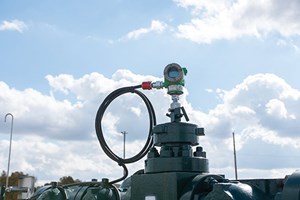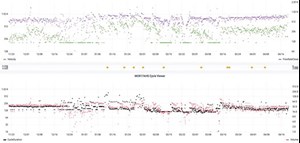Reducing GHG emissions, increasing production for plunger lift applications in the Marcellus shale
The United States Energy Information Administration (EIA) estimates that global energy consumption will increase 50% over the next 30 years. And while renewable energy sources like solar and wind will grow significantly during this period, petroleum and other liquid fuels will remain the world’s largest energy source in 2050. Meeting growing demand for oil and gas is not the only challenge operators are facing; the industry is also working aggressively to reduce its carbon footprint and minimize GHG emissions associated with oil and gas production.
For the industry to address this dual challenge of meeting growing energy demand but also doing so more sustainably and efficiently than in the past, digital innovations like cloud computing and artificial intelligence are providing a clear path forward. For operators like CNX Resources, leveraging the latest advances in digital innovation are helping to revamp legacy operations and improve and optimize overall performance, while reducing the carbon footprint associated with its operations.
CNX Resources is a premier natural gas development, production, midstream, and technology company, with operations throughout the Appalachian basin, primarily in the Marcellus and Utica shales in Pennsylvania, Ohio and West Virginia. The company is continuously reducing GHG emissions year-over-year, while also investing capital in emissions reductions technologies that will further help to reduce its Scope 1 and Scope 2 CO2e emissions. The company has reduced GHG emissions by 90% since 2011.
CNX sought to optimize production and reduce the number of liquid loading events across its horizontal Marcellus shale wells with plunger lift systems deployed. As a result, the CNX operations team vented wells regularly to remediate liquid loading, leading to challenges across emissions profile, productivity and efficiency. To overcome these challenges, CNX worked with Ambyint and Amazon Web Services (AWS) to deploy a solution capable of optimizing well productivity with improved analytics and autonomous management. This resulted in improved production volumes and workforce efficiency, with no additional hardware required.
PLUNGER LIFT APPLICATIONS IN THE MARCELLUS SHALE
The Marcellus shale formation is one of two prolific dry natural gas plays within the Appalachian basin, which spans parts of Pennsylvania, West Virginia and Ohio. Per the EIA, production in the region has been growing since 2008. Monthly production recently set new record highs—reaching 32.5 Bcfgd in December 2020, and it averaged 31.9 Bcfgd during the first half of 2021, the highest average for a six-month period since production began in 2008. The Marcellus and Utica shale plays accounted for 34% of all U.S. dry natural gas production in the first half of 2021.
Many gas-producing wells in the Marcellus experience liquid loading at some point during production, which negatively impacts overall well economics. Liquid loading is the inability of a producing gas well to remove its co-produced liquids from the wellbore. The liquid flowing as droplets or film accumulates at the well bottom, thereby imposing backpressure at the sandface and triggering increasingly higher pressure loss in the wellbore. The problem initiated by liquid loading is manifested in terms of loss of well deliverability, causing the wellhead pressure to decline significantly, which, in turn, leads to the cessation of gas production. Accordingly, the liquid-loading issue reduces the ultimate recovery of a gas well.1

Plunger lift is an artificial lift method used principally in gas wells to unload relatively small volumes of liquid. An automated system, mounted on the wellhead, controls the well of an intermittent flow regime. When the well is shut-in, a plunger is dropped down the production string. When the control system opens the well for production, the plunger and a column of fluid are carried up the tubing string. The surface equipment receiving the mechanism detects the plunger when it arrives at surface and, through the control system, prepares for the next cycle.
DATA-DRIVEN AND CLOUD-BASED PLUNGER LIFT OPTIMIZATION
Ambyint works with oil and gas producers to improve production outcomes and margins by combining advanced physics and subject matter expertise with artificial intelligence to automate operations and production optimization workflows across all well types and artificial lift systems.
Ambyint is part of the AWS Partner Network (APN), a global community of partners that leverages programs, expertise and resources to build, market and sell customer offerings, and has also achieved AWS Energy Competency status. This designation recognizes that Ambyint has demonstrated deep expertise and technical proficiency working with operators to leverage AWS cloud technology to transform complex systems and accelerate their digital transition to a sustainable energy future with confidence. Ambyint’s production optimization applications leverage AWS’s cloud environment to integrate easily with existing E&P companies’ systems, such as supervisory control and data acquisition (SCADA) and production accounting, providing real-time ingestion, standardization, normalization, and contextualization of oil and gas operations data.
Ambyint’s production optimization applications are part of the AWS production optimization solution, aimed at helping E&P companies increase productivity, using data and insights for production operations use cases. The solution focuses on two use cases, artificial lift optimization and full-field optimization.
For artificial lift optimization, the solution helps operators find setpoints that are likely to increase productivity and avoid unnecessary downtime across all types of artificial lift, including electric submersible pumps (ESPs), plunger lift, rod lift, and gas lift. For full-field optimization of networked resources, accounting for the dependencies between wells in the same field in a way that maximizes production while minimizing downtime, is driven using advanced physics combined with artificial intelligence.
Ambyint utilizes a variety of AWS services to drive its cloud-based applications, including Amazon Elastic Kubernetes Service (Amazon EKS), Amazon Simple Storage Service (Amazon S3), Amazon Virtual Private Cloud (Amazon VPC), Elastic Load Balancing (ELB), and Amazon Timestream for horizontal and vertical scalability, all of which enable production optimization at scale—a critical requirement for E&P companies focused on delivering the substantial benefits that digital transformation and operational excellence initiatives offer.

The Ambyint InfinityPL™ plunger lift optimization solution running on AWS is specifically designed to help operators like CNX Resources increase production on plunger lift wells by detecting anomalous behavior and determining optimal controller setpoints. Anomalies are common on plunger lift applications, affecting all wells at some point in their lifecycles. Further, identifying anomalies can be labor-intensive, requiring manual inspection of real-time operations data. Failure to identify and remediate anomalies in a timely manner eventually leads to negative impact on production and workforce efficiency.
While plunger lift systems are mechanically simple, they produce vast amounts of data, all of which can be leveraged to optimize performance. However, data analysis required to uncover insights is time-consuming and often manual, leading to undetected production-impacting anomalies that typically worsen and further deteriorate over time. In addition, operational personnel must focus on a limited subset of wells each day, which means anomalies are missed.
Utilizing existing SCADA infrastructure as the operational data source, the cloud-based plunger lift optimization application provides operations and engineering teams the ability to optimize plunger lift wells. This is done by combining advanced wellbore physics modeling with data driven analytics methods, and by analyzing every cycle, interval, and production stream continuously to identify production risks and uplift opportunities.
Asset optimization. For asset optimization, the cloud-based plunger lift application’s modern physics engine provides an accurate model of the wellbore. Computed cycles, by trigger type, surface in the action panel of a novel optimization page, which enables more well data to be analyzed in less time, provides deep insights for improved decision-making, and enables operators to easily and quickly identify optimization opportunities with the cycles keyboard and spotlight view.
Predictive maintenance. Identifying problems before they happen helps operators manage plunger lift wells proactively instead of reactively, which can help to significantly reduce downtime and increase overall production. The cloud-based plunger lift optimization application continuously performs analysis across every cycle to identify anomalies, such as data quality, arrival, motor valve, and sensor issues, as they occur. The application’s dashboard spotlights anomalies for proactive remediation, thus avoiding larger issues in the future.
Set-point management. Physics-based artificial intelligence and proprietary optimization algorithms provide set-point recommendations, such as which open and close triggers to enable, and which set-point values will maximize production.
System interoperability. Interoperability and integration at scale are integral. The data-driven, cloud-based plunger lift optimization solution provides data management, an open API, and a third-party adapter library to deliver secure and robust read-and-write capabilities with existing SCADA and PLC/RTUs. The application is compatible with all major SCADA platforms, mapped for all major controllers, can be integrated into cloud-based data lakes for operating or reporting use, and is secure by design across data transport and cloud storage.
INCREASING PRODUCTION, REDUCING EMISSIONS
Across its horizontal Marcellus shale wells with plunger lift systems (Fig. 1), CNX experienced liquid loading events, and production challenges. CNX operations teams were regularly venting the wells to mitigate the issues.
The InfinityPL application was deployed to CNX’s plunger lift wells, allowing for enhanced analytics, improved physics-based insights, and autonomous management of plunger open/close triggers and other setpoints. As part of the deployment, the application leveraged the AWS cloud environment for seamless data integrations with CNX’s existing SCADA and production accounting systems, but with no new hardware needed.
Through automation and proactive management, CNX was able to improve well stability, which led to opportunities for performance optimization, and ultimately a reduction in venting events and GHG emissions, Fig. 2. Through reduced liquid loading and well venting events, CNX realized a 48% reduction in GHG emissions. When extrapolated, this reduction translates to a 18-Mt reduction in CO2e emissions per well, per year. In addition, predictive maintenance and autonomous management of control system settings resulted in a 4% increase in gas production.
An added benefit was enhanced workforce efficiency, which was achieved by reducing the number of screens to review for data, leveraging simplified workflows, and automating manual tasks, in addition to reducing trips to the field. Based on the success of the 26 pilot wells, CNX expanded the work to an additional 120 wells.
ADDRESSING THE INDUSTRY IMPERATIVE
Digital innovation is playing an integral role in helping the industry address the dual challenge of meeting growing demand for energy while simultaneously reducing the carbon footprint associated with oil and gas production. For an E&P company like CNX Resources that significantly values ESG stewardship, leveraging the breadth and depth of the cloud, combined with advanced domain-specific applications like the Ambyint InfinityPL, helps to quickly identify emerging well problems and optimize predictive maintenance opportunities, implement ideal controller set-points for optimal production, and maintain well stability to improve reliability. All of this leads to increased natural gas production, while also driving reductions in GHG emissions.
REFERENCE
- Riza, M. F., A. R. Hasan and C. S. Kabir. “A pragmatic approach to understanding liquid loading in gas wells,” SPE Prod & Oper 31 (2016): 185–196. doi: https://doi.org/10.2118/170583-PA
- Drilling advances and where they’re headed (July 2024)
- Executive viewpoint (June 2024)
- Can an offshore drilling rig run on green methanol? (May 2024)
- De-risking carbon sequestration projects with comprehensive reservoir monitoring (March 2024)
- Solutions for decarbonizing offshore power generation (April 2024)
- The last barrel (December 2021)



